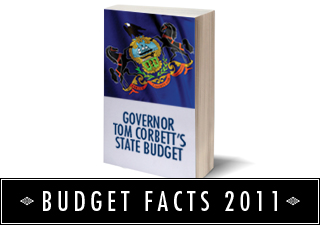Fact Sheet

Natural Gas Taxes and Fees
Gov. Tom Corbett’s FY 2011-12 budget proposal includes $63.6 billion in total operating spending-$27.3 billion in General Fund spending-a reduction of $3.3 billion from FY 2010-11. This budget restores overall spending to pre-stimulus levels and proposes no new taxes. This is the seventh in a series of fact sheets on the state budget.
Pennsylvania’s Natural Gas Boom
- The Marcellus Shale is a large and difficult-to-drill geological formation roughly a mile or more underground throughout more than two-thirds of Pennsylvania that contains natural gas.
- Estimates place recoverable gas in the entire formation (not just Pennsylvania) at 489 trillion cubic feet—enough to supply all of America’s natural gas needs for 20 years.
- Since 2005, 7,060 Marcellus Shale permits have been issued and 3,075 wells have been drilled. More than 19,200 non-Marcellus wells were drilled over the same time.
Economic Impact of Drilling
- Dozens of drilling companies are investing in Pennsylvania.
- Employment statistics show a surge in mining and natural resource jobs—climbing 25.5% between 2010 and 2011, when overall job growth in Pennsylvania was less than 2%.
- The Center for Workforce Information & Analysis estimated average annual earnings for employees in the gas industry was $63,553 in 2008.
- Penn State economists estimate Marcellus activity spurred more than 88,000 new jobs by 2010.
- According to FBR Capital Markets, Marcellus development will produce $8 to $15 billion in economic activity each year in the state.
- From 2006 to 2011, the Pennsylvania Department of Revenue has reported the natural gas and related industries paid more than $1.1 billion in state taxes.
- Pennsylvania counties with 150 or more Marcellus wells experienced an 11.36% increase in state sales tax collections between 2007 and 2010, while counties with no Marcellus wells drilled experienced a 6.55% decrease.
- The state expects to receive $60 million in royalties from drilling on state-owned lands in FY 2011-12.
- Local communities are benefiting from increased property values, local hotel taxes and processing fees.
- In 2010, Bradford County received an estimated $1 million from the drilling industry through minor revenue streams like recording and copying fees.
- While state law requires drilling companies to repair damaged roads, many drilling companies are going the extra mile to improve roads.
- The Marcellus Shale Coalition estimates the drilling industry paid out $200 million in privately funded road repairs in 2010.
- These investments are saving local governments money, and are providing transportation funding far above what these communities receive from the state.
- Since 2006, the industry is estimated to have paid out over $7 billion in lease and royalty payments, which are taxable by the state.
Natural Gas Tax Facts
- Gov. Tom Corbett has signed a pledge to not raise taxes or fees.
- A severance tax or impact fee would also impact Pennsylvania landowners, because a typical lease splits tax obligations between drilling companies and landowners.
- Drillers already pay the other taxes common to every other business in Pennsylvania, as well as leasing fees, and royalty payments to landowners. There’s no tax loophole for drillers to escape paying taxes.
- While the drilling industry won’t disappear if a severance tax or impact fee is enacted, there will be an impact—through reduced investment in the state, lower wages, reduction in job growth or a reduction in spending on things like road improvements.
- Proposed severance taxes or fees would be on top of Pennsylvania’s current tax structure and regulatory costs.
Impact Fee vs. Tax
- Most proposed impact fees are actually taxes based on natural gas prices and well production, with no direct correlation to the industry’s impact that isn’t currently being compensated.
- Many proponents insist the whole state should benefit from this “fee,” not just the areas impacted. This includes environmental funds and programs like Growing Greener.
- Growing Greener was created as a temporary program, focusing on buying open spaces and farmland, funded through new state debt, which won’t be paid off for at least another 30 years. The fund subsidizes alternative energy companies and distributes grants to environmental groups lobbying for a natural gas tax.
- Any severance tax should be entirely dedicated to address actual costs incurred by communities; however, these impacts are being paid for under the state’s current laws and regulations.
- Pennsylvania laws ensure drilling companies, not taxpayers, are held responsible for environmental and infrastructural damages.
- State oversight for drilling is entirely funded through natural gas permits. Drillers paid $11 million in permitting fees in FY 2009-10.
- When EOG Resources failed to have a backup pressure barrier at their well and fracking fluids spilled in Clearfield County, the company paid eight times in fines the cost for the investigation and cleanup—$400,000 for a $50,000 accident.
- Drilling companies are required to put up bonds for all posted roads and bridges, and repair any damage they cause.
- Drillers are responsible for any groundwater contamination within 1,000 feet of each well.
- Tax supporters highlight the fact that other states have a natural gas tax; however, this is only part of the story.
- Most state’s with difficult-to-drill shale formations have reduced or delayed their severance taxes for gas wells to allow drilling companies to recoup their up-front costs.
- Other states that have been considered “models” for a natural gas tax—Texas and Wyoming—have neither income nor corporate taxes.
- Pennsylvania has the 10th highest tax burden in the nation and is one of the most expensive states in which to drill; it cost $1 million more to drill a shale gas well in Pennsylvania than Texas.
# # #
For more information on the Pennsylvania State Budget, visit CommonwealthFoundation.org/Budget.